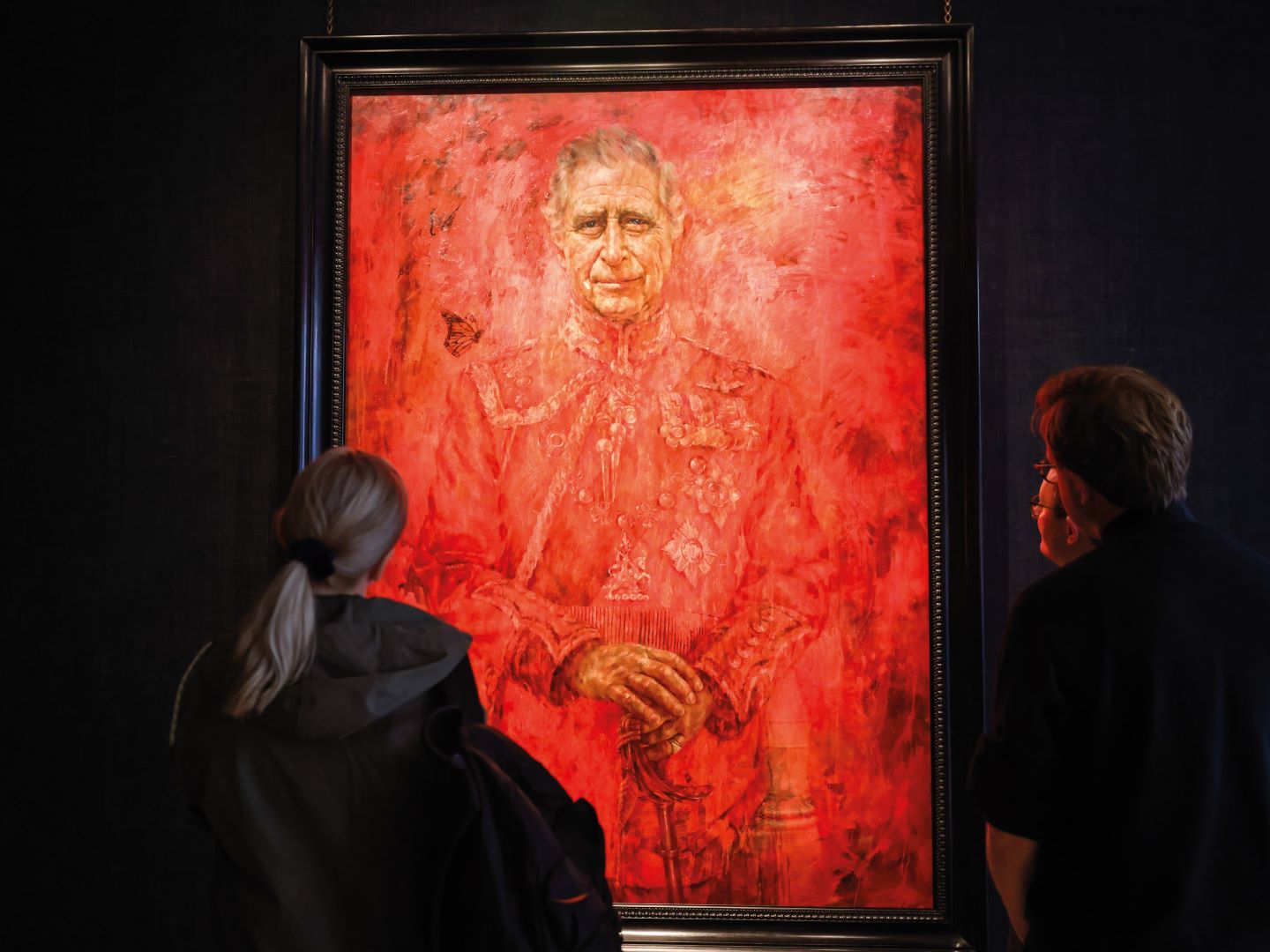
The King is depicted, sword in hand, with a butterfly landing on his shoulder (Photo: Reuters)
Bland”— but what else could it be, really? For radical, or irreverent, it would be best to step into the set of Spitting Image where, through the decades, the large-eared Charles is depicted practising being King. A particularly acerbic skit features Charles sitting in a small chair in a junior classroom, knees reaching up to his ears — again, large and deeply contoured — stressing “I do read books, and yes I do have children — William; em, and the other one …”
Lucian Freud was an irreverent choice: Commissioned to portray Charles’ mother, Her Majesty Queen Elizabeth II, the brilliant if prickly Freud fell back nicely on the urgings of his surname, adopting a deeply psychological rather than symbolic approach, greatly decreasing the size of the conventional portrait to a near miniature and, employing all the powers of the slab he is renowned for, puffed the jowls and upper neck of Her Majesty, leaving an impression of the Queen, according to popular opinion, “looking like a corgi”.
Meanwhile, Andy Warhol’s silkscreen series on Queen Elizabeth II, certainly not royally commissioned, dragged Her Majesty from the sombre settings of the palace into the realms of celebrity, alongside the likes of Marilyn Monroe.
But what, after all, is an official portrait?
The insightful art critic Peter Conrad, writing in The Guardian on this recent unveiling, puts it sharply, “Portraits of kings, presidents, prime ministers and the like are effigies, meant to replace the mortal being. Once the official image has been fixed in place, the living subject can be sent off to die. The unveiled portrait draws a veil over another ceremonial occasion — what we are looking at is posterity’s verdict, so in effect we are attending a funeral.”
And it is the effect of the funereal — along with the deeply discerning, effecting almost a sense of the prescient — that bequeaths certain portraits its eternality. Reflect on the portrait of Henry VIII by Hans Holbein the Younger, with its merciless gaze, fixed through eyes of steely blue; or the portrait of Pope Innocent X as malicious and malevolent by Velasquez, drawing a shocked response from “His Eminence” as “too true, too true”. Centuries later, this portrait would be shockingly reinterpreted by Francis Bacon in the form of the melting Pope, marked by a cavernous mouth of pink.
Few, though, beyond the obsessive collector of Crown memorabilia, stalking the lanes of the National Portrait Gallery or Parliamentary Art Collection, would recall the portraits of Herbert James Gunn or William Oliphant Hutchison.
Of royal portraits and their purpose, Dorothy Wilding, official royal photographer of the better-remembered first official photographic portrait of Queen Elizabeth II, had simply this to say, “It is an honour to photograph the Queen”.
Upon the unveiling of this, Jonathan Yeo’s “divisive” portrait, the normally already quite ruddy King is recorded as exclaiming, “That is quite red indeed”. The response from Queen Camilla of “You’ve got him” set the likes of X (formerly Twitter) and countless faceless commentators ablaze with recollections of a once secretly recorded conversation between the then-married to Diana, Prince Charles, and Camilla, with its brazen reference to Tampax.
For the portraitist Yeo, however, the entire process comes across as simply formulaic — imagined through still images and formal sittings — and it began while the present king was then still Charles, Prince of Wales.
“You never know how long these things will take, they have a life of their own,” Yeo says in a TV interview. But in the course of the “life of its own”, the prince is finally crowned king, giving new meaning to the butterfly (described by some observers as “clunky”) depicted just above the king’s right shoulder the added symbolism of “metamorphosis” to the already extant “environmentalist”.
“Each of us has our biography etched on our faces,” the painter explains, and may describe then the rather pained expression of the monarch, thin-lipped, half smiling and stooping, enveloped in a sea of red, the colours of the Royal Welsh Guard.
Mannered and undistinguished, the portrait has nevertheless drawn hardly any praise and much derision from a highly “democratised” art public who have read the red as either too lurid, or representative, in this age of deep historical indignation, as the “blood of Empire”.
Hardly anywhere is there sympathy for the artist — Yeo — whose main purpose, he states, was simply to “recreate the sense of being someone”.
Yet, for all its enveloping redness and stiff butterfly, it is precisely this ordinariness which mostly serves as the hallmark of the portrait.
A king, now stricken with cancer, divested of all the power and “divine right” red of the Royal Welsh Guard, rather than serve as “a sea of blood” remains just that, the colours of the Royal Welsh Guard, and seems to be the only testament to this commissioned Royal Portrait, not unlike those of Gunn and Hutchison.
For those expecting Yeo’s earlier work of “King George” — George W Bush, post-9-11, depicted using parts of a pornographic magazine — following a commission later retracted, there is little of such limited “experimentation” for this one of the king. This will simply rest in Yeo’s assemblage along with the, yes, mannered and run-of-the-mill portraits of Tony Blair, and countless other celebrities, on the shelves of the common portrait.
Oscar Wilde and his powerful The Picture of Dorian Gray have often been invoked in discussions of this unveiling, but it is perhaps Beckett — that prophet of ennui — that may encapsulate the culture of portraiture best. “My mistakes are my life.”
This article first appeared on May 27, 2024 in The Edge Malaysia.


